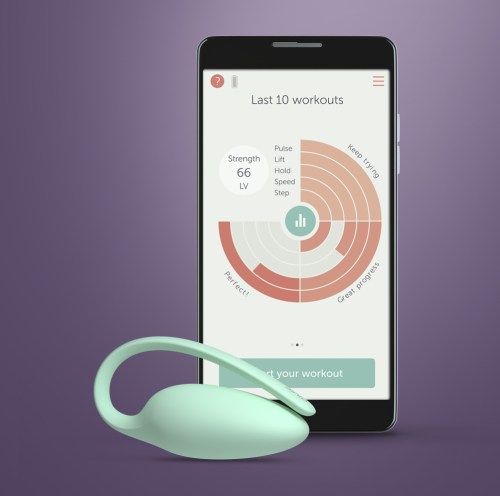Our editors independently select these products. Making a purchase through our links may earn Well+Good a commission
The 8 Most Enlightening Things We Learned About Our Pelvic Floors This Year
From how to locate them to why they cause headaches, these are the most important things we learned about our pelvic floor muscles this year.

This time last year, we here at Well+Good were just beginning to unveil our wellness trend predictions for 2022. Alongside a broadened use of psychedelics to treat depression and abortion pills becoming more easily available via snail mail, we predicted that the pelvic floor—the sling of muscles running from the pubic bone to the tailbone between your hips—would become a hot topic in wellness spaces. We hate to toot our own horn (sorry), but it seems like our prediction came true: Public interest in the pelvic floor health has boomed.
Experts in This Article
CEO and founder of The Bloom Method
pelvic floor therapist at the New Jersey-based Renew Physical Therapy
Pilates trainer and postpartum corrective exercise specialist
doctor of physical therapy, owner of Femina Physical Therapy, and author of Sex Without Pain
physical therapist and founder of Pelvic Floored
Throughout the year, our reporting on the pelvic floor unveiled a multitude of surprising truths, including the legitimacy of Kegels, the negative impacts of sucking in your stomach 24/7, and how great pelvic floor health can positively impact the rest of our body. Read on to see the eight most enlightening infobits we discovered about our pelvic floors in 2022.
8 things we learned about the pelvic floor this year
1. Exactly how to find and activate our pelvic floor muscles
Since the 1940s, doctors have known that the pelvic floor muscles don’t operate alone. “Your pelvic floor was designed by nature to work in tandem with the diaphragm and the rest of the core, and with the breath,” postpartum corrective exercise specialist Emma Bromley told us earlier this year.
But unlike core muscles like your hips, glutes, and abs, which are easy to spot, locating and properly engaging your pelvic floor muscles can be a bit tricky. Prenatal and postnatal exercise specialist Brooke Cates equipped us with nine methods to engage them earlier this year, including diaphragmatic breathing, deep squats, and internal strengthening devices like the Elvie Trainer.

Elvie Trainer — $199.00
2. What it’s like to visit a pelvic floor physical therapist
Well+Good author Natalie Arroyo Camacho took a wellness leap earlier this year by setting up an appointment with Femina Physical Therapy founder and physical therapist Heather Jeffcoat, DPT. FYI, pelvic floor physical therapy aims to rehabilitate the multitude of muscles that make up the area, which run from the pubic bone to the tail bone between your hips, improving sexual dysfunction, urinary incontinence, and chronic constipation.
Camacho shares that the appointment felt more like a check-up at the doctor rather than a physical therapy session (think: patient gowns and exam tables, not sweatpants and medicine balls). Like many pelvic floor physical therapists, Dr. Jeffcoat uses a three-pronged approach to rehabilitation, focusing on the bladder, the bowels, and sexual organs, while performing internal and external examinations on her clients. Because of the comprehensive nature of these visits, setting up an appointment with a pelvic floor physical therapist could reveal important insights into your sexual, urinary, or gastrointestinal dysfunction.
3. Sucking in your stomach all the time can harmful
If you’re constantly “sucking it in” in an attempt to look smaller, you could be putting yourself at risk of developing chronic tension because doing so places loads of pressure on your core, which in turn presses down on your pelvic floor. This constant pressure, according to physical therapist Chelsea Waldkirch, can lead to serious woes down the road, including dysfunction, stress incontinence, painful sex, and pelvic organ prolapse (when these muscles can no longer support the organs in your pelvic girdle, including your bladder, uterus, and bowels, causing one or more to slip into your vagina). So remember: Your body is beautiful, bellies are normal, and appearing slightly thinner isn’t worth the harm to your health.
4. Not everyone *needs* to do kegels
“Do your Kegels” is decent enough advice for maintaining a healthy pelvic floor, but like most wellness tips, it’s not a one-size-fits-all solution. In fact, Kegels can do more harm than good, depending on the person. While people with relaxed or weaker pelvic floors can benefit from a few daily Kegel contractions, those with hypertonic pelvic floors (tight, non-relaxing) could experience worsened symptoms. “It’s easy to say, ‘Hey, just do some Kegels for your pelvic floor dysfunction,” Dr. Jeffcoat recently told Well+Good . “But that doesn’t align with normal muscle function and how underlying dysfunction can be exacerbated by performing inappropriate exercises.”
5. Strengthening it can improve your workouts
It’s pretty obvious that our pelvic floor holds the key to our sexual, urinary, and gastrointestinal health, but the benefits of a pelvic floor that functions optimally extends beyond our midsection. A well-trained pelvic floor directly impacts our strength and balance, according to physical therapist Kelly Sadauckas, DPT.
“The pelvic floor is literally the base of our core,” Dr. Sadauckas explains. “Along with our abs and hips, it stabilizes our pelvis for powerful movements—think sprinting, jumping—as well as pliability for allowing complex movements of the back, pelvis, and hips—think yoga and rock-climbing.” When it’s unstable, instability appears in all other areas of our physical fitness, including everything from walking upstairs to lifting heavy weights.
6. We can use it to combat constipation
Our first instinct when we’re constipated is to labor over the toilet, straining and pushing to try to induce a bowel movement. Rather than helping us poop, though, this added pressure is rarely effective and can cause anal fissures. By contrast, relaxing your pelvic floor muscles can help move things along in a pinch, says Dr. Jeffcoat. To get things moving even faster, try deep breathing, taking a break from the toilet, switching up your diet, or adding a Squatty Potty to your bathroom.

Squatty Potty The Original Bathroom Toilet Stool — $34.00
ThirdLove Just Launched Bras That Help Balance Your Body Temperature—Here’s Why That’s a Game-Changer for Women in All Life Stages

These Are the Only Types of Underwear You Should Be Wearing, According to Gynecologists

These Are the Summer Essentials You Should Bring With You Every Time You Leave the House, According to a Derm and an RD

7. Pelvic floor tension can cause headaches
Turns out, the areas in our cerebral cortex that control the head, neck, and pelvis sit closely together in the brain. Pelvic tension can therefore affect areas of the brain responsible for the head and neck, thus causing a headache. If a headache is ruining your day, take into consideration your recent bathroom trips; if you’ve been straining more than usual, there’s a chance your pelvic floor could be the cause of it.
8. How to stretch out a tight pelvic floor
Like all muscles, our pelvic floor muscles can benefit from a good stretch. If you’ve been experiencing the tell-tale signs of a tense pelvic floor— painful sex, headaches (see above), chronic constipation, or urinary incontinence— it may be high time for a pelvic floor stretch sesh. Earlier this summer, pelvic floor physical therapist Kristina Kehoe, DPT, shared with us six guaranteed ways to stretch out your pelvic floor, including child’s pose, diaphragmatic breathing, and deep squats.
Depending on the current state of your pelvic floor, adopting any (or all) of these pro tips could help make 2023 the healthiest year yet for this oh-so important set of muscles.
Sign up for the Well+Good SHOP Newsletter
Get exclusive deals on wellness, beauty, fitness, and food products that have been hand-picked by our editors.
Got it, you've been added to our email list.







